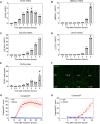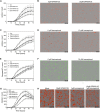DUX4 expression activates JNK and p38 MAP kinases in myoblasts
- PMID: 36196640
- PMCID: PMC10655719
- DOI: 10.1242/dmm.049516
DUX4 expression activates JNK and p38 MAP kinases in myoblasts
Abstract
Facioscapulohumeral muscular dystrophy (FSHD) is caused by misexpression of the DUX4 transcription factor in skeletal muscle that results in transcriptional alterations, abnormal phenotypes and cell death. To gain insight into the kinetics of DUX4-induced stresses, we activated DUX4 expression in myoblasts and performed longitudinal RNA sequencing paired with proteomics and phosphoproteomics. This analysis revealed changes in cellular physiology upon DUX4 activation, including DNA damage and altered mRNA splicing. Phosphoproteomic analysis uncovered rapid widespread changes in protein phosphorylation following DUX4 induction, indicating that alterations in kinase signaling might play a role in DUX4-mediated stress and cell death. Indeed, we demonstrate that two stress-responsive MAP kinase pathways, JNK and p38, are activated in response to DUX4 expression. Inhibition of each of these pathways ameliorated DUX4-mediated cell death in myoblasts. These findings uncover that the JNK pathway is involved in DUX4-mediated cell death and provide additional insights into the role of the p38 pathway, a clinical target for the treatment of FSHD.
Keywords: MAP kinase signaling; Muscular dystrophy; Phosphoproteomics.
© 2022. Published by The Company of Biologists Ltd.
Conflict of interest statement
Competing interests At the time that these studies were performed, C.M.B., A.S.H., M.S.A., X.L., V.M., S.G., L.X., T.G., A.H., M.M., R.M., J.O., and N.C. were all Pfizer employees and declare potential conflicts of interest due to income received from their employment.
Figures







References
-
- Bennett, B. L., Sasaki, D. T., Murray, B. W., O'Leary, E. C., Sakata, S. T., Xu, W., Leisten, J. C., Motiwala, A., Pierce, S., Satoh, Y.et al. (2001). SP600125, an anthrapyrazolone inhibitor of Jun N-terminal kinase. Proc. Natl. Acad. Sci. USA 98, 13681-13686. 10.1073/pnas.251194298 - DOI - PMC - PubMed
Publication types
MeSH terms
Substances
Associated data
LinkOut - more resources
Full Text Sources
Other Literature Sources
Molecular Biology Databases
Research Materials

